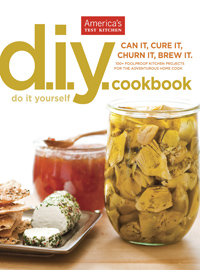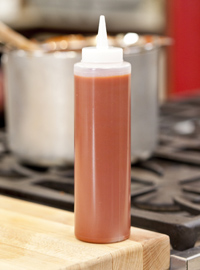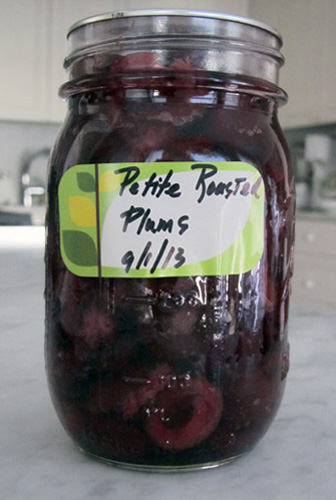A City Cook's DIY
I long ago gave up on TV cooking shows except for the occasional America's Test Kitchen and Barefoot Contessa, both of which are in the category of what TV cooking execs have come to derisively call "dump and stir" programs. Julia Child wouldn't stand a chance on The Food Network.
Instead my favorite resources are books, cookbooks both old and new, and food magazines. And I read cooking blogs, although selectively and in small doses because otherwise they can instill a looming sense of inferiority. If I spend an afternoon trolling food blogs it becomes like the time I binge-watched nearly an entire season of Mad Men, which tipped me into such a depression that I almost started smoking again. Food blogs aren't that dark -- on the contrary, they're relentlessly cheerful -- but I do find myself getting intimidated by so much striving ambition, not to mention the time, grocery bills, and calories incurred to cook in these hyper-pixeled ways. If I visit too many blogged kitchens I not only don't get inspired, I also have the opposite reaction and end up like Mary Tyler Moore in her eponymous show's opening credits, dismissively tossing a package of chicken into a grocery cart.
It doesn't help that some of the food blogs are literally competitions. I once submitted a recipe to a blog holiday recipe contest. I didn't win and I never tried again, likening the experience to when years ago I bought a lottery ticket. I figure that if you try a game and you lose, this is not something you should be playing. Move on.
But when I turn away from the computer screen and instead actually talk with other home cooks, I get reassured and inspired. There is much good cooking taking place in city kitchens, showcasing the confidence that comes from knowing there is little that can please more than a well roasted chicken and a salad tossed with a signature dressing.
These conversations have also helped me see a trend hardening into normal. And that is DIY. Do it yourself. More and more of us are making ingredients that we previously bought ready-made. We're finding the time to do this, we're honing our skills, and it's becoming a routine part of our cooking.
Why DIY?
Back in the day, home cooks made things because there was no alternative. Or no refrigeration. Many of today's processed foods are factory versions of what was originally homemade, or home brewed, or home pickled. Modernity and commerce created food factories, populations grew and had to be fed, time became scarce with everyone working outside the home, and advertising convinced us that factory-made was better than homemade. How else can we explain Tang?
But we pay a price in food additives and flavor when we trade craft for convenience. So new generations are discovering that many processed foods are in fact really easy to make yourself and truly worth the trouble. Many of us already bake our own bread, make our own salad dressings, and whisk our own mayonnaise. From here it's not a giant step to our own canned plum tomatoes, nut butters, strawberry jam, bacon, hot sauce, ketchup, paté, mozzarella, corn chips, beer, or yogurt. We're learning how to can, freeze, pickle, cure, butcher, brew, and churn and we're using these skills in our routine cooking in our urban kitchens.
There are several good reasons to make instead of buy certain foods. First, we get to preserve the season. Tomatoes canned in August and added to a stew in February should make the point.
DIY is also a way to eat without chemicals, preservatives and fillers. Make your own and you can know exactly what's in your dinner. Next, because you make it yourself, you can suit your own taste. If you want a spicier chutney or smokier bacon, go right ahead. Fourth, it can save money, although sometimes it costs more to make rather than buy (if you make your own ketchup it won't compare well to the price of that Costco bottle).
DIY will also demystify ingredients. After a lifetime of opening jars of mustard, once you make your own (which is quite simple to do) you'll have more appreciation for its flavor and nuance when using it in recipes. DIY rarely requires suiting up, although you may need an occasional new tool or ingredient. Mostly all that's needed is a little time, and lots of patience.
My friend Roy Finamore gave me a treasure of a book called Aunt Freddie's Pantry, Freddie being the aunt to nephew Lee Bailey whose work Roy knows I so admire (and he was Lee Bailey's editor). This small volume is a hint to what may have inspired nephew Lee because it's filled with Aunt Freddie's wisdom plus her recipes for preserves, relishes, and other pantry foods as well as what goes with them. By the time you get to page 51 and her recipe for Pepper Jelly Glazed Ham served with Hot Mustard Sauce (recipes included for the jelly, the ham, and the sauce), you won't again ask the question -- why bother?
My DIY
I choose my spots when it comes to DIY. Here are the things I currently make rather than buy:
- Canned tomatoes. I both can summer tomatoes plus buy ones in actual cans. For the past three summers I have spent a late August Saturday afternoon peeling, quartering, and canning six quarts of tomatoes. That's about 18 pounds of raw tomatoes. I save these to use in recipes other than sauces. That means that six times this coming winter I'll be able to give a huge flavor boost to my favorite short ribs, vegetable soup, or veal stew. For tomato sauce I happily use canned Italian San Marzano tomatoes (imported from Italy and marked DOP, not those awful California ones that are branded as San Marzano). Some prefer to freeze rather than can their summer tomatoes. I frankly don't have room in my freezer to do this, but I can always find space somewhere for six glass quart jars of NJ tomatoes.
- Canned sour cherries. This is a laborious task because you have to pit every cherry. Plus it's not a bargain since the only place I ever find sour cherries is at my Greenmarket and the number of quarts of in-season cherries needed to produce six canned pints adds up. But a jar of local sour cherries roasted alongside duck or pork is one of my favorite dishes and something I do often for company. So this is a DIY luxury.
- Canned roasted plums with thyme. A few weeks ago I was loitering at my weekly Greenmarket, visiting the farmers from Locust Grove who always has the best stone fruit, apples, pears and grapes. Plums were at their height and the farmer was talking with another regular customer who is a manager and ingredient buyer from Dan Barber's restaurant at Blue Hill Farm. I crashed the conversation to hear more about how the chefs at Blue Hill Farm would be roasting some of the same Castleton plums I was buying and then canning them for winter menus when they'd be served with cheese as a starter course. I'm happy to copy such inspiration and now have six pints of plums I roasted with sprigs of thyme waiting for my winter dinners.
- Worcestershire sauce. It takes a long list of inexpensive ingredients, a dark and cool space, and several weeks of patient waiting to make Worcestershire sauce, an ingredient I use primarily in Caesar salad dressing and bloody Marys. But it's pure umami, lasts forever, and once you taste your own, you'll never use Lea & Perrins again.
- Preserved lemons. These are essential for Moroccan cooking and their silky texture can transform many recipes from compound butters to martinis. Still it's both a search to buy them already made plus the cost is crazy when all you need to make your own is a glass jar, about 8 lemons, a pile of salt, and a month of waiting. My refrigerator always has a jar of them ready to go.
- Seltzer. Okay, this is a cheat because we got one of those SodaStream machines. It doesn't achieve quite the needlepoint fizz of a chilled Perrier, but I love eliminating all those bottles and making seltzer out of our superb NYC tap water.
- Duck confit. It takes some sourcing for the duck legs and duck fat (I get mine at Esposito's in Hell's Kitchen), plus a little time. But the process is easy and the result is a huge reward, at a fraction of what commercial confit duck legs cost.
Things I'm Planning To DIY
Bacon, because my local Whole Foods butcher always has gorgeous fresh pork belly and I love knowing I can have bacon without the chemicals. Crème fraîche because I don't use it that often but when I do I always wince at the price; in fact you can make it with only heavy cream and a little buttermilk, and less than a day's wait. And finally dukkah, the north African mix of nuts, seeds, and spices that is hard to find, costly to buy, and never assuredly fresh. Whereas it's easy to source the ingredients at most grocers (a spice market like Kalustyan's or Euro Market or Sahadi's is even better), and it's a snap to make with a food processor.
Things I Wouldn't DIY
Because I only have so much time and storage space, I am selective about my DIY. For instance, I only use ketchup in my meatloaf glaze so it makes no sense to make something that only keeps for a month; for someone else, maybe with small children who put the stuff on everything, ketchup would be the first thing I'd make. I also won't make mozzarella, pancetta, or mortadella because I have easy access to great Italian grocers and I respect their craft. Finally I won't make wine vinegar because its primary ingredient is good wine and I frankly would rather drink it than put it on my salad. Plus there is never leftover wine in our house.
DIY Special Equipment and Ingredients
The tools you'll need will depend upon what you DIY but mostly you'll use what you probably already have, assuming you have a food processor. But if you want to make paté or sausage, you'll need a meat grinder (or attachment for your KitchenAid). Canning needs a large pot, plus jars, lids, and tongs to lift the glass jars out of the boiling water. Some hot sauce recipes call for a French press. You'll also need storage space for whatever you're making so that you'll have a place to keep it, as well as storage containers that are suitable, such as little sealed jars for vanilla extract or Worcestershire sauce.
It's the same for ingredients. Most are quotidian. But making vinegar requires a mother of vinegar cultures. Cheese calls for rennet. And beer needs special yeast. Not ordinary ingredients but also not really that hard to find.
Getting DIY Help
Depending on what you want to DIY, there are several ways to get instruction. If you're interested in doing something that requires serious skill and equipment, you can check out the area's cooking schools that increasingly have classes in such things as pig butchering, sausage making, cheese making, or home brewing. The Brooklyn Kitchen is an excellent choice.
But most DIY only requires a good book or two. There are many of them about canning and preserving. When it comes to canning, whether sweet preserves or tangy pickles, I highly recommend the Ball Corporation Blue Book of Preserving as a primer with all the USDA rules. If you want to get more recipes, books by The River Cottage and Linda Ziedrich are good choices. Just be sure to choose ones with a clear explanation of the food safety science needed for safe canning
For a broader take on food preservation, one of the best is Eugenia Bone's Well-Preserved. The New York Times did an article about Eugenia and her book a couple of years ago; there's a link to it below. Plus we've added a link to our podcast interview we did with her at the time her book came out. You can't find a better guide than Eugenia.
If your DIY interest is in meat, the master is Michael Ruhlman. His book Charcuterie, written with Brian Polcyn, is the bible for the home cook.
Finally, for a look at DIY that goes both wide and deep, a great choice comes, not surprisingly, from America's Test Kitchen. Their D.I.Y. Cookbook, Can It, Cure It, Churn It, Brew It, is from our most trusted expert in how to get success in the kitchen. Knowing their competency with thousands of recipes and choosing kitchen equipment, we can also trust them when it comes to what they call "foolproof kitchen projects for the adventurous home cook." This 360-page paperback (© 2012, $26.95) has 800 color photos supporting 106 recipes in eight categories, from pantry items to beverages, that will guide you in making yogurt, goat cheese, prosciutto, sriracha, vanilla extract, sauerkraut, tofu, beef jerky, sausage, hot cocoa mix, root beer, vermouth, beer, and much more. Some things will be for regular eating but others may be the best gifts you could ever make.
We got permission to share two of this book's recipes that could be starter DIY recipes. One is for almond butter (all you need is a food processor) that if eaten when still warm, will ruin you for ordinary peanut butter. The second is for ketchup. I've been told by ketchup aficionados (I'm not one so I can't vouch) that once you've made your own, you'll never go back to Heinz. See our links to the recipes.
If the price, artificiality, and even toxicity of our prepared foods aren't reasons enough to DIY, at least consider the confidence that comes from knowing we can make almost anything we want. Plus it's lots of fun. I mean, how can you not have fun making your own marshmallows?
Ball Blue Book Guide To Preserving
The River Cottage Preserves Handbook


